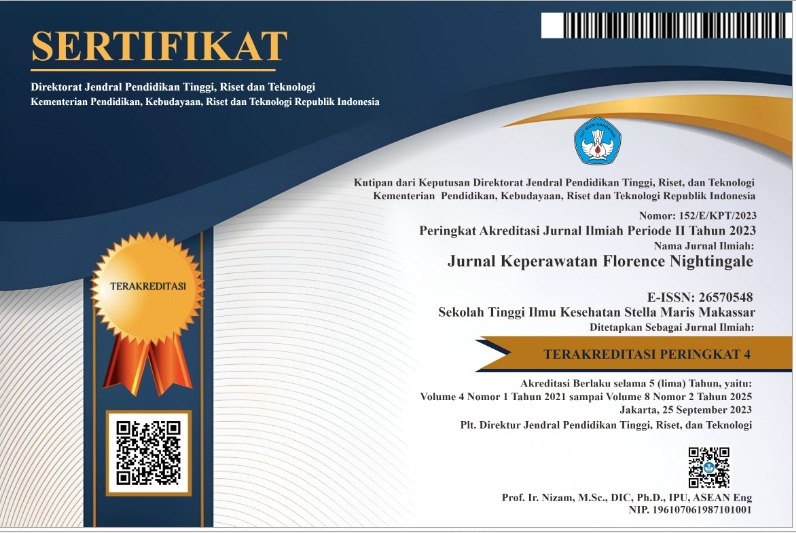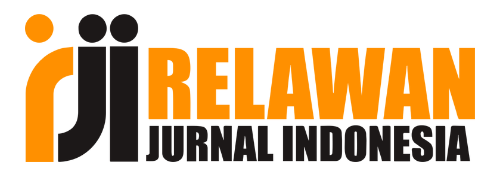Analysis of the Accuracy of Triage in Patients in the Emergency Department
Keywords:
knowledge, accuracy of triage, nurseAbstract
Triage nurses have an important role to save patients, patients who come to the emergency department are stabilized and categorized based on severity. The accuracy of triage is a guarantee of patient safety. The purpose of this study was to analyze the relationship between the level of nurse knowledge and the accuracy of triage in patients in the emergency department. The research design in this study used a quantitative research design with a cross sectional approach. Research data were collected using a research instrument with a questionnaire of nurse knowledge and Standard Operational Procedure (SOP) triage accuracy. Data were analyzed with the SPSS program presented in the form of frequency tables and cross tables to analyze the relationship between the level of knowledge and accuracy of triage. Data analysis using Kendall's test. The results of the study obtained a Sig. (2-tailed) of 0.000 (<0.005), it can be concluded that there is a relationship between the level of nurse knowledge and the accuracy of triage in patients. The Correlation Coefficient value is positive at 0.648, it can be concluded that the direction of the relationship between the two variables is unidirectional and has a strong relationship, this shows that a good level of nurse knowledge will affect the accuracy of appropriate triage, in this case the nurse's knowledge about triage is very important and needs to be improved so that the accuracy of triage is in accordance with the patient's condition.
Downloads
References
Amaral, T. M., & Costa, A. P. C. (2014). Improving decision-making and management of hospital resources: An application of the PROMETHEE II method in an Emergency Department. Operations Research for Health Care, 3(1), 1–6. https://doi.org/10.1016/j.orhc.2013.10.002
Benner, P. (1982). From novice to expert: Excellence and power in clinical nursing practice. American Journal of Nursing, 82(2), 402–407.
Benner, P., Tanner, C. A., & Chesla, C. A. (2009). Expertise in Nursing Practice Caring, Clinical Judgment & Ethics (A. Graubard (ed.); second). Springer Publishing Company.
Blum, C. A. (2010). Using the Benner intuitive-humanistic decision-making model in action: A case study. Nurse Education in Practice, 10(5), 303–307. https://doi.org/10.1016/j.nepr.2010.01.009
Christ, M., Grossmann, F., Winter, D., Bingisser, R., & Platz, E. (2010). Triage in der notaufnahme. Deutsches Arzteblatt, 107(50), 892–898. https://doi.org/10.3238/arztebl.2010.0892
Damansyah, H., & Yunus, P. (2021). the Relationship Between Triage Assessment Accuracy and the Success Rate of Patient Handling in the Emergency Room At M.M Dunda Hospital Limboto. Jurnal Zaitun, 09(02), 999–1008.
Gibbons, L. J., & Stoddart, K. (2018). ‘Fast and frugal heuristics’: Clinical decision making in the Emergency Department. International Emergency Nursing, 41(April), 7–12. https://doi.org/10.1016/j.ienj.2018.04.002
Gillespie, M., & Peterson, B. (2009). Helping Novice Nurses Make Effective Clinical Decisions: The Situated Clinical Decision-Making Framework. Nursing Education Perspectives, 30(3), 164–170.
Goldstein, R. S. (2005). Management of the critically ill patient in the emergency department: Focus on safety issues. Critical Care Clinics, 21(1), 81–89. https://doi.org/10.1016/j.ccc.2004.10.001
Hadi, A. B. (2016). Gambaran Pengetahuan dan Peneraan Triage Oleh Perawat di Instalasi Gawat Darurat RSUD Dr.Soediman Kebumen. Applied Microbiology and Biotechnology, 85(1), 6.
Herawati, T., Gustina, D. S., & Utami, D. S. (2019). Pelaksanaan Triage Oleh Perawat Di Instalasi Gawat Darurat Rsud Lembang. Jurnal Ilmiah JKA (Jurnal Kesehatan Aeromedika), 5(1), 59–64. https://doi.org/10.58550/jka.v5i1.22
Johansen, M. L., & O’Brien, J. L. (2016). Decision Making in Nursing Practice: A Concept Analysis. Nursing Forum, 51(1), 40–48. https://doi.org/10.1111/nuf.12119
Kwon, S., Kim, M., & Choi, S. (2020). Nurses’ experiences of providing “sensitive nursing care” for terminally-ill individuals with cancer: A qualitative study. European Journal of Oncology Nursing, 101773. https://doi.org/10.1016/j.ejon.2020.101773
Laeke, T., Tirsit, A., Debebe, F., Girma, B., Gere, D., Park, K. B., & Azazh, A. (2019). Profile of Head Injuries: Prehospital Care, Diagnosis, and Severity in an Ethiopian Tertiary Hospital. World Neurosurgery, 127, e186–e192. https://doi.org/10.1016/j.wneu.2019.03.044
Maryah Ardiyani, V., Titin Andri, M. W., Eko, R. K., & Magister Keperawatan Gawat Darurat Fakultas Kedokteran Universitas Brawijaya, P. (2015). Analisi Peran Perawat Triage Terhadap Waiting Time Dan Length of Stay (LOS) Pada Ruang Triage Di Instalasi Gawat Darurat RS dr. Saiful Anwar Malang. Jurnal CARE, 3(1), 39–50. https://jurnal.unitri.ac.id/index.php/care/article/view/302
Mukhtar, H. M. E., & Fadlallah, E. A. (2020). Nurse’s Knowledge Regarding Triage Sistem At Emergency Departments in Public Hospital At Khartuom State. International Journal of Management and Applied Science, 5(1), 15–17. https://www.iraj.in/journal/journal_file/journal_pdf/14-530-155495780227-30.pdf
Payne, L. K. (2015). Toward a Theory of Intuitive Decision–Making in Nursing. Nursing Science Quarterly, 28(3), 223–228. https://doi.org/10.1177/0894318415585618
Peraturan Menteri Kesehatan Republik Indonesia No. 47 Tahun 2018 tentang Pelayanan Kegawatdaruratan, (2018).
Putri, M. P. E., Rasyid, T. A., & Lita. (2022). Gambaran Pelaksanaan Triage Di Instalasi Gawat Darurat (IGD) RSUD Raja Musa Sungai Guntung Kabupaten Indragiri Hilir. Hang Tuah Nursing Journal, 2(2), 194–204.
Rochana, N., Morphet, J., & Plummer, V. (2016). Triage process in Emergency Departments: an Indonesian Study. Nurse Media Journal of Nursing, 6(1), 37–46. https://doi.org/10.14710/nmjn.v6i1.11819
Rumampuk, J., & Katuuk, M. E. (2019). Hubungan Ketepatan Triage Dengan Response Time Perawat Di Instalasi Gawat Darurat Rumah Sakit Tipe C. Jurnal Keperawatan, 7(1). https://doi.org/10.35790/jkp.v7i1.25206
Rustiawati, E., Sulastri, T., & Dewi, N. H. (2021). Pengaruh Pelatihan Triage Terhadap Pengetahuan Perawat Dan Bidan Tentang Penerapan Triage Di Unit Gawat Darurat Puskesmas …. Jurnal Ilmiah Keperawatan, 2(1), 23–28. https://jurnal.untirta.ac.id/index.php/jik/article/view/14342%0Ahttps://jurnal.untirta.ac.id/index.php/jik/article/download/14342/8612
Sockeel, P., De La Villeon, B., Goudard, Y., Goin, G., Monchal, T., & Pauleau, G. (2017). Medical and surgical triage. Journal of Visceral Surgery, 154, S13–S17. https://doi.org/10.1016/j.jviscsurg.2017.07.006
Yunita, D., Tiara, Marlinda, Nuria, & Sari, R. (2024). Hubungan Tingkat Pengetahuan Perawat Dengan Penerapan Triage Di Instalasi Gawat Darurat (Igd) Rsud Pringsewu. Jurnal Penelitian Sistem Kesehatan, 1(1), 1–12.
Published
How to Cite
Issue
Section
Copyright (c) 2025 Baitus Sholehah, Anisa Nur Laili, Arika Azizah

This work is licensed under a Creative Commons Attribution-ShareAlike 4.0 International License.









